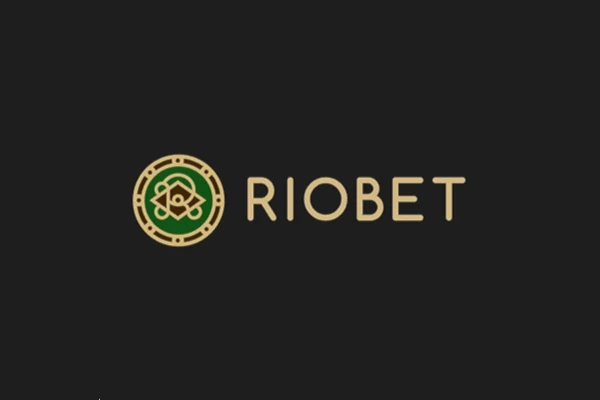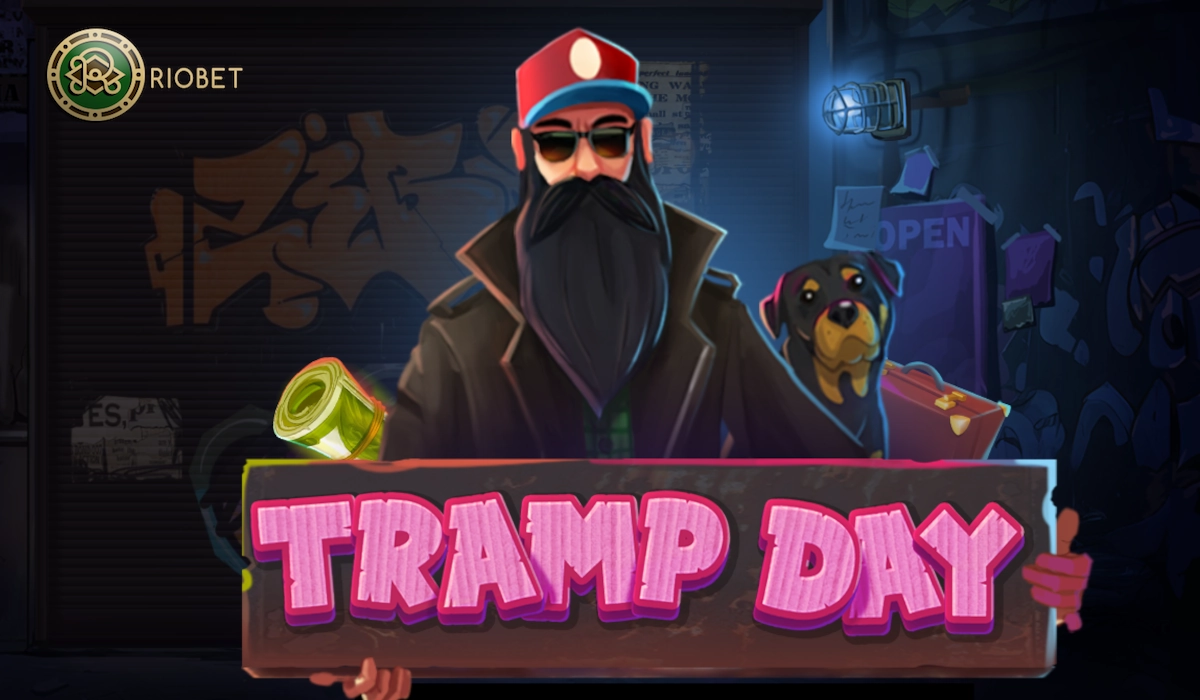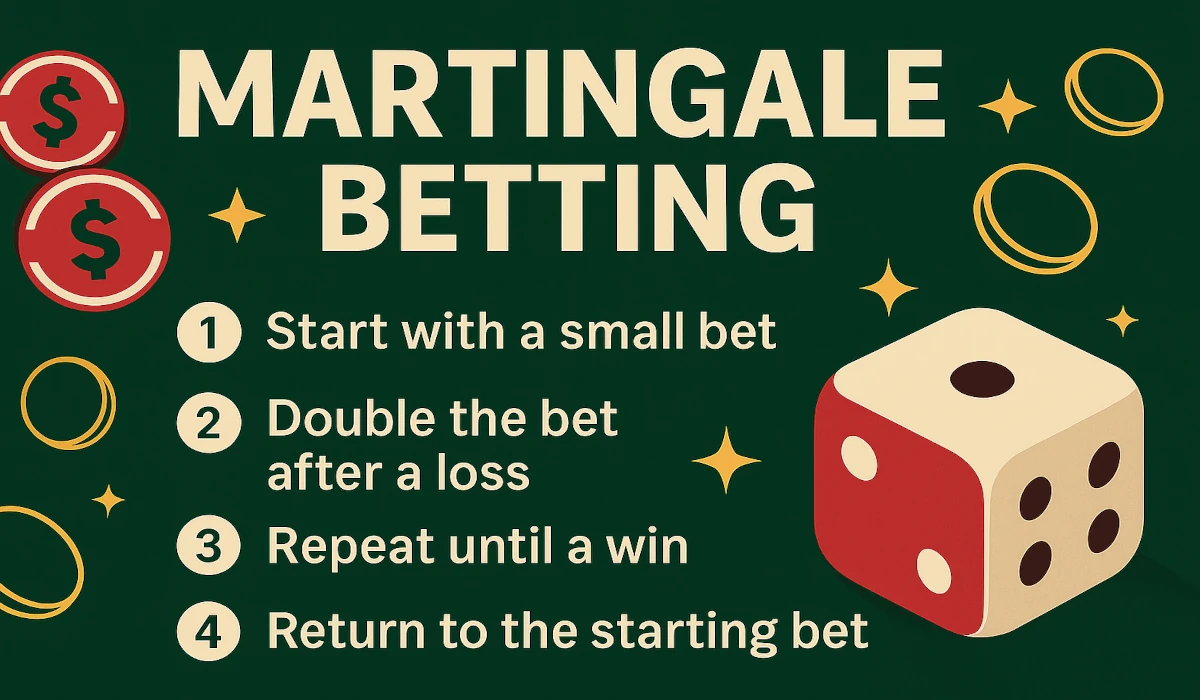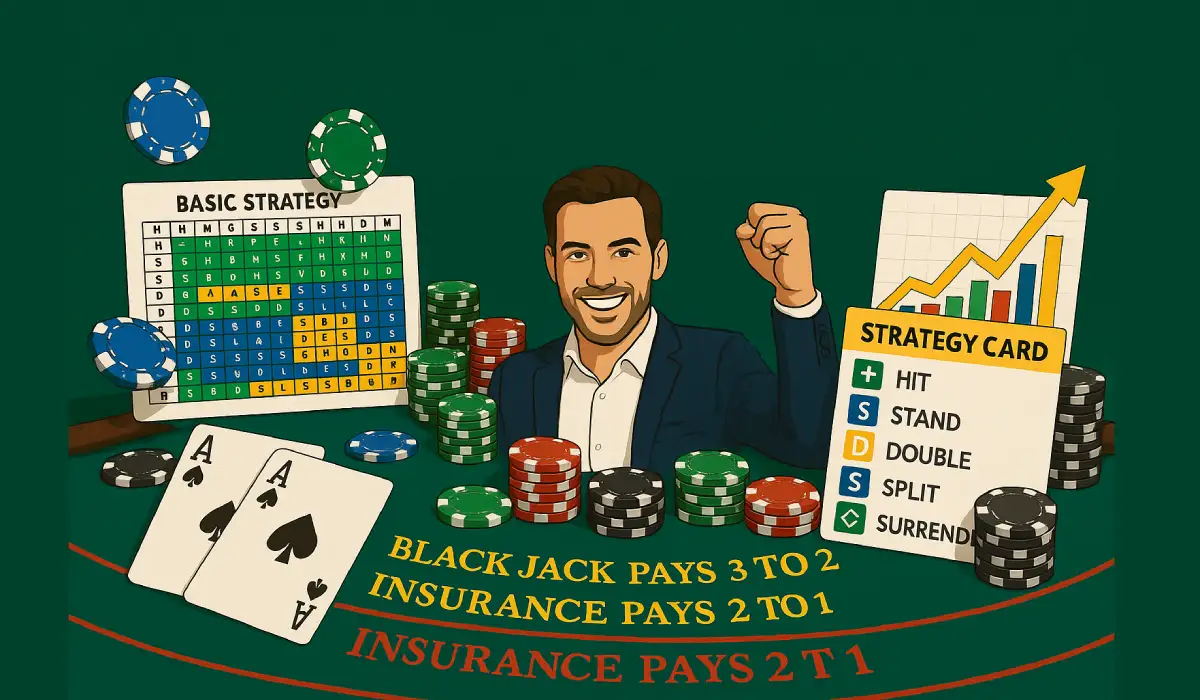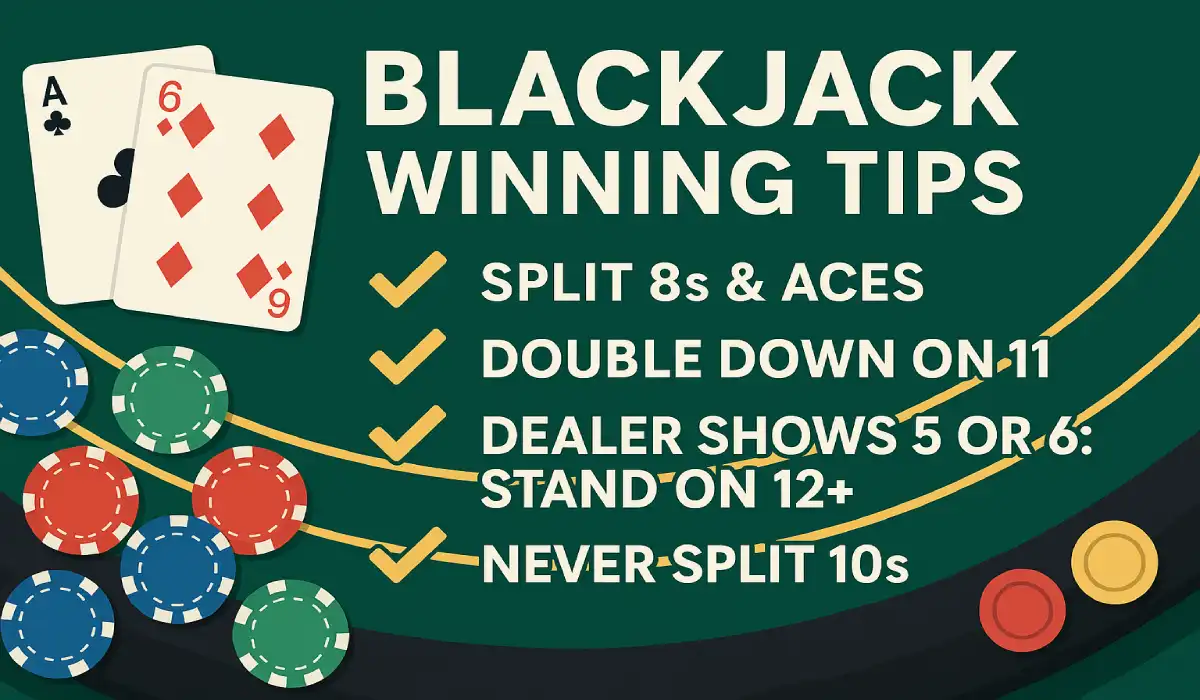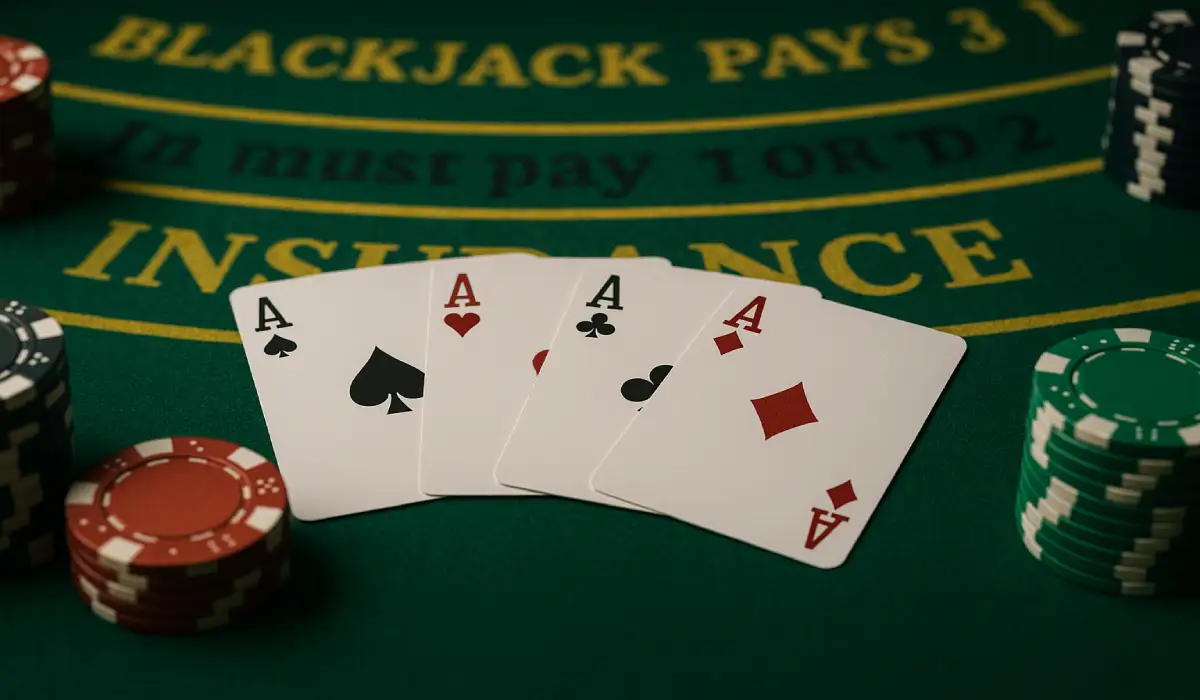
05 Jul 2025
What Is an Ace in Blackjack?
🗝️ Key Takeaways
- In blackjack, the Ace holds a flexible value—sometimes treated as 1, other times as 11—depending on what benefits the hand most.
- Knowing the difference between soft hands (Aces counted as 11) and hard hands (Aces counted as 1 or zero Aces) is essential for making the best strategic choices and avoiding busting.
- The flexibility of the Ace, toggling its value as needed within a player’s hand, highlights the need for situational awareness and constant evaluation during every hand.
- In basic strategy, the Ace affects when you should hit, stand, and double down, and you gain from always factoring in the dealer’s upcard before making your decision.
- While splitting Aces can maximize potential profits, beware if the house limits your options post-split.
- Understanding and overcoming typical misconceptions about Aces allows for smarter decisions, while deliberate risk management and psychological insight can give you an advantage at the table.
An ace in blackjack is the most versatile card, counted as either one or eleven points, depending on which benefits the player. Its value varies with each hand, frequently assisting in the creation of a ‘blackjack,’ a winning hand made up of an Ace and a card with a value of ten.
In almost all games, the player values the ace for increasing probability or decreasing variance, so it’s a key element of any blackjack strategy. Rules on the ace may vary by casino or variation, but its two-way value is always central.
To assist card sharks, young and old, the meat digs into the ace’s role, its impact on hand values, and strategies to leverage it effectively.
⚖️ The Ace's Dual Value
The ace in blackjack is special because it’s flexible. Unlike other cards, the ace can count as either 1 or 11 points, depending on whichever is more favorable to the player's hand.
This dual value is fluid, moving with your hand, allowing you to tailor your play hand-by-card drawn. The ace’s dual value provides players an essential weapon for attack and defense alike, defining how hands are played and strategies constructed.
This dynamic makes the ace central to many blackjack terms and terminologies.
1. The Flexible Eleven
We tend to think of the ace as a power card when counted as 11, particularly when it’s dealt at the beginning of a hand. If you have an ace and a 7, you can count the ace as 11, giving you a “soft 18.”
This is a soft hand since you can take another card without busting. Consider an ace and 6; you can stand on 17 or take a hit and pray.
If you hit a 4, it brings you to 21, which is perfect. Knowing when to hit the ace as 11 is key to upping your hand value, particularly if the dealer has a weak 5 or 6 showing.
Determining when to count the ace as 11 is all about properly evaluating your total. If your hand is low and additional cards won’t bust you, consider the ace as 11 to give yourself the best odds.
This decision-making process plays a critical role in any good strategy guide.
2. The Safety Net One
The ace’s other value—1—provides a vital safety margin. It’s true that often you’d bust with extra cards, but with an ace, you can just count it as 1 and stay in the game.
If you begin with an ace and 7 (soft 18) and then draw a 9, you would bust at 27 if the ace continued to count as 11. Making the ace a 1, your hand is now 17.
Knowing when to bring that ace down to a 1 can convert a losing hand into a push or a win. The ace’s capability to convert to 1 at the perfect moment is what makes it so excellent for extended play.
This kind of flexibility is why the ace card is so valuable in various types of blackjack.
3. The Soft Hand
Soft means you have an ace counted as 11, so you can’t bust with the next card. For example, an ace and a 5 equals a soft 16.
You can even hit without peril, as the ace can always slide down to 1, and your hand is still alive. Soft hands give you a hammer swing, particularly when the dealer jockey is up a creek.
If you pull a 10 on a soft 16, sure, you now have a hard 16, but you didn’t bust.
Soft totals are the heart of flexible blackjack strategy. They assist you in playing the odds, providing you with additional opportunities to beat the dealer by leveraging probabilities effectively.
4. The Hard Hand
A hard hand is any hand where the ace counts as 1 or does not exist. These hands eliminate the ace’s safety net, causing busts to be more common.
For instance, a 10 and a 7 is a hard 17. There is no bust potential, and most players will stand instead of taking a chance on going over 21.
Hard hands signify limited possibilities. You can’t pay so aggressively, as you have to play safer and avoid busting.
The stakes are greater and choices become more inflexible. Hard hands demonstrate why the ace’s dual values are crucial for players who want to minimize mistakes.
5. The Automatic Switch
The ace’s value in blackjack is not rigid. It switches automatically based on your hand total.
If the ace were to be valued at 11 and that would bust your hand, it automatically drops to 1 with no additional action required. Example: Say you begin with ace-6 (soft 17), hit, 9. Now, the ace becomes 1, for a total of 16.
This flexibility keeps players afloat, and out of trouble. It’s wise to simulate toggling the ace’s value in your mind as your hand develops.
Being willing to adapt makes for superior play. Understanding this also enhances your ability to follow the best advice in a cheat sheet.
📋 Ace in Basic Strategy
The Ace is the most adaptable card in blackjack. It acts as either a 1 or 11, providing players that special advantage and additional methods to construct a powerful hand.
Recognizing the Ace’s power forms the heart of basic strategy, boosting your odds and driving every decision, from hitting to double down in blackjack. Combined with another card, the Ace can generate a “soft” hand, providing both protection and power.
Smart Ace plays, either with a point card or as a split, are key to basic strategy.
🎯 Hitting
A soft hand, like Ace-6, is safer to hit since the Ace can “flex” between 11 and 1. In other words, pulling a high card won’t result in an instant bust, because the hand can flip from soft to hard.
For instance, if you have Ace-7 (soft 18) and hit a 9, the hand is now hard 17, not 27. This flexibility is crucial.
Players get additional cards to better hands with an ace. Hitting on soft totals can take a so-so hand and transform it into an unbeatable one against a dealer’s upcard in the 4, 5, or 6 range.
For instance, you hit Ace-2 vs. A dealer’s 6 because you’re less likely to lose by busting, yet have a good chance to improve. Always check the dealer’s upcard—if they’re showing strength, like a 10 or Ace, hitting could be your best chance.
🧍 Standing
Standing with an Ace is smart when you have a solid soft total, like A-9 (soft 20). This secures a strong total and prevents busting, particularly when the dealer’s upcard is poor.
Take, for instance, Ace-8 against a dealer 5 – standing locks in a premium hand.
Sometimes saving your hand is smarter than risking a bust. For instance, on Ace-7 if the dealer has a 2 or 8.
Knowing what the dealer’s upcard is will help you determine the best play. If the dealer is busting, it’s usually best to stand on a soft 18 or higher.
💰 Doubling Down
Doubling down is doubling your bet and getting one additional card. With an Ace, say Ace-7, this can be a powerful play.
For instance, doubling on Ace-6 versus a dealer’s 5 provides the player with the best opportunity to beat the dealer. The Ace is a game-changer when doubling down, particularly with soft hands.
With Ace-2 through Ace-7 and the dealer’s up card is 5 or 6, doubling down is usually your best play because there are more ways for you to create a solid hand and the dealer is in a vulnerable position.
- Always check the dealer’s upcard before doubling down.
- Double only when the dealer is weak (normally 4, 5 or 6).
- Doubling on soft hands provides you insurance if you pull a low card.
- Don’t double if the dealer’s upcard is an Ace or a 10.
⚡ The Power of Splitting Aces
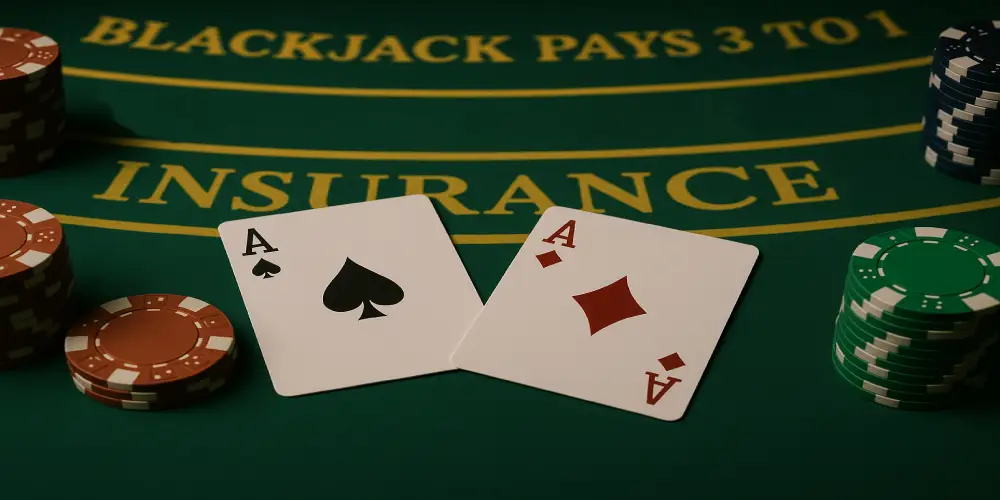
Splitting aces is one of the most powerful moves in blackjack, allowing a gambler to receive two aces and treat each as a new hand. This converts a weak beginning into two hands that have good chances of beating the dealer, as each ace can turn into 11 or 21 if you get a ten-card.
Most table rules permit a player to split aces once. However, some casinos allow additional splits, or “resplits,” if yet another ace appears.
Players typically have to equal their original bet for the new hand, so both hands are played at the same stake.
Whether you split aces should consider the dealer’s up card and the house rules. Even more valuable, for instance, is splitting aces against a weak upcard (2–6).
Some casinos even have a “Split Aces” side bet, which pays a bonus if your initial cards are aces, or if those aces wind up blackjacks. The house edge on this side bet is roughly 0.43%, which is low in comparison to the majority of casino bets.
| Benefit/Strategy | Description | Example |
| Turns weak hand strong | Two aces split become two hands with strong win odds | A♠, A♦ split: A♠+K♥, A♦+9♣ |
| Maximizes payout potential | Each ace can win or push, not just one low hand | Both hands beat dealer |
| Resplitting option | Some rules let you split again if you get more aces | A♠, A♦ → A♠+A♣ → three hands |
| Side bet available | “Split Aces” side bet rewards getting aces and blackjack after split | Win bonus on suited blackjacks |
🃏 The Ace and the Dealer
To master ace blackjack, you need to consider how it affects the dealer’s hand — in particular, the dealer’s upcard. The ace can take on a value of either 1 or 11, adjusting automatically to improve the total hand score for both the player and the dealer.
It is the dealer’s upcard that drives many player decisions, forming the basis of your risk-reward strategy. Ace-dealer rules shift the momentum of each round.
🌟 Dealer's Upcard
The dealer’s upcard is the only card the players see. When the dealer is showing a strong card (ace, king, queen, jack, or ten), the risk to you goes up.
If the dealer’s upcard is weak (two through six), the potential for busting becomes greater for the dealer. With an ace in hand, players have to balance these signals—hit, stand, or split—against what the dealer flaunts.
If you have an ace and the dealers card is 7 or higher, then be much more conservative. For instance, with ace-seven you might hit instead of stand.
Now, when the dealer displays a softer card, like a five, the same ace-seven hand becomes beefier – you could stand or even double down. Players who moderate their play by observing the dealer’s upcard will frequently steer clear of expensive errors, especially if they understand blackjack rules.
💫 Insurance Bet
Blackjack insurance is a side bet that is available only when the dealer’s upcard is an ace. If the dealer lands a blackjack, the payout is 2:1.
The general concept is to safeguard your principal wager from a dealer blackjack, yet insurance is a crapshoot. The odds are against the player.
You’d think it was a safe bet, but repeated insurance wagers are money losers.
Others accept insurance with a solid 10-value card, anticipating at least a push if the dealer peeks blackjack. For the most part, the pros say to avoid insurance unless you’re card counting or otherwise know something about the deck. That’s too much risk for most.
♠️ Dealer Upcard and Player Ace Strategy Table
| Dealer Upcard | Player Soft Hand (Ace+7) | Recommended Action |
| 2–6 | Ace + 7 (Soft 18) | Double if allowed; otherwise, stand |
| 7–8 | Ace + 7 (Soft 18) | Stand |
| 9–A | Ace + 7 (Soft 18) | Hit |
📜 Importance of Dealer Rules with Aces
Dealer rules count. Certain casinos have the dealer hit soft 17 (ace+6), while others stand.
This alters the house edge and your optimal plays. As always, know the house rules before you play.
Dealer regulations determine how you play your aces. Dealer stands on soft 17 gives players a slight edge with an ace.
If the dealer hits on soft 17, it is even worse for the player. Always check the table rules, as even a single detail can alter your odds.
🔍 Beyond the Basics: Ace Perception
Aces in blackjack provide more than mathematical significance. How players and dealers perceive them influences the gameplay, affects risk, and creates opportunities for ingenuous strategies.
When you bring ace perception into the discussion, strategy moves beyond the fundamentals of probabilities toward subtle mind games and grand strategy, particularly for experts or professionals.
🧠 Psychological Edge
Ace up your sleeve a mighty powerful message. Dealers are under additional stress when a player exposes an ace, particularly because the ace can be combined with a ten-value card for a blackjack.
Players with aces tend to pick up on this, too, garnering a psychological advantage from realizing their hand has the top potential.
An ace gives you confidence, but it’s not mere superstition. Bold play—like splitting aces or doubling down—imposes a psychological burden on opponents and the dealer.
With the ace’s dual value (1 or 11), players can switch tactics mid-hand, keeping opponents guessing and off-balance. To employ this edge, players remain cool and unemotional, never trembling with nervousness or bouncing with excitement when receiving an ace.
Subtle acts, such as deliberate decision making, can bolster an impression of power. Working your memory to follow ace peeks inserts an additional level, allowing players to predict premium moments for optimal effect.
📉 Risk Management
Risk management with aces is understanding when to play safe and when to push. The ace’s ambiguity (1 or 11) facilitates blackjack’s high-stakes gambles, but only when the time is right.
If the count indicates that most aces remain in the deck, it is reasonable to bet more. In single-deck games, if few aces have come up, it might be wise to push the bets later in the hand.
Counting risk means looking for bunches of tens or small cards. If a few aces have already come up, safe hands win.
Splitting aces is old hat, but not the way to go if you’ve got an ace-poor shoe. Every ace decision must consider the deck, recent shuffles, and cards on the table.
Players have to remain flexible. By guessing ace positions post-shuffle and tracking high or low cards, you can control risk and increase long-term returns.
💡 Strategic Deception
Aces are keys for bluffing and misdirection. Displaying confidence with an ace, or conversely acting hesitant, can induce errors from others.
For instance, pausing before ‘splitting aces’ can fool others into thinking your hand is weak — and altering their bet.
In multiplayer games, concealing that thrill of drawing an ace can maintain the mystery of your actual hand power. Timing matters: make bold moves when opponents least expect them—like doubling down after a shuffle that likely left aces near the top of the deck.
Expert players utilize memory to monitor how shuffles impact ace distribution, anticipating when one will surface next. Deception is at its most effective when layered with good instincts about odds, deck factors, and the table vibe.
🚫 Common Ace Misconceptions
For blackjack players, there are a lot of things that your average player believes about the ace, but some of these notions miss the mark and can alter your strategic play. Knowing the truth helps players avoid expensive errors, so let’s dispel some prevalent ace myths.
Here are some of the most common myths and then the reality to clear things up.
1. A lot of people think ace prediction is easy. They figure that, if they study the cards carefully, they’ll be able to detect when an ace is about to turn up. In reality, the shuffles, the deck penetration, the game’s randomness they all make reliable ace prediction incredibly difficult.
Even professional players with intimate card knowledge find it difficult to anticipate aces with any consistency.
2. Others say ace prediction can provide a massive advantage, with figures floated around in the neighborhood of 3-4%. It’s usually founded on small sample sizes or corrupted studies.
Studies indicate the actual advantage from ace foresight is typically less. The impact of ace tracking is more ambiguous than certain outlets allege, and numerous specialists contend the advantages are exaggerated.
3. A common ace misconception is that pulling all the 10s out of the shoe increases the chance of hitting an ace. Taking 10s out does impact the deck and can alter the odds of aces being dealt, but not necessarily in a manner more favorable to the player.
The reality is more nuanced, and the rise in ace prevalence is less inevitable than some think.
4. A few believe that the shuffle method–riffle, for example, or overhand–is not a big concern, but shuffle techniques can influence the distribution and dispersion of aces. Riffle shuffles, for instance, may produce “zero-card interlacings” more frequently than assumed, leaving cards, such as aces, clustering, or separating in patterns that undermine ace prediction techniques.
5. We humans see these strategies, and we trust them because we think they are a shortcut to huge victories. As many experts have discovered, the math behind ace sequencing is not always so solid, and the asserted advantage is frequently not supported by evidence.
The underlying assumptions in these strategies aren’t always valid in actual games.
🔒 Conclusion
To recap, the Ace is amazing in blackjack. It creates more opportunities to win and defines how players strategize every hand. No other card comes with so much promise or trouble.
An ace allows you to create a soft hand or aim for a powerful blackjack, and it keeps you alert with the dealer’s up-card. A lot of rookie players believe that an ace is always a guaranteed winner.
In reality, it’s more like a weapon you have to wield correctly. As you play more, you pick up on how the Ace swings from round to round.
Continue studying, experimenting with moves, and sharing your victories and lessons. So does the Ace.
Frequently Asked Questions❓
What is the value of an Ace in blackjack?
It shifts value to make the strongest hand that can’t bust.
Why is the Ace so important in blackjack strategy?
The Ace’s versatility is what makes it strong. It’s what helps make those hard to beat hands, like a ‘soft’ 17 or a natural blackjack.
Should you always split Aces in blackjack?
Yeah, basic strategies say you always split Aces. This provides you with a pair of opportunities to hit that big hand, boosting your odds of success.
How does the dealer’s Ace affect gameplay?
When the dealer has an Ace, the odds change. Dealers can have a solid hand, too, so you have to tweak your strategy and potentially take insurance.
What is a “soft” hand in blackjack?
A ‘soft’ hand contains an Ace valued as 11. Soft 17s, like Ace and 6. If you get a high card, the Ace can become 1.
Are there common mistakes with Aces in blackjack?
Yes, some forget that the Ace can switch or don’t split Aces. Some people overvalue insurance bets when the dealer has an Ace.
Can you take insurance when you have an Ace?
Yes, you may, but it’s not typically advised. Insurance is a side bet that the dealer has blackjack, but it almost never helps the player in the long run.
